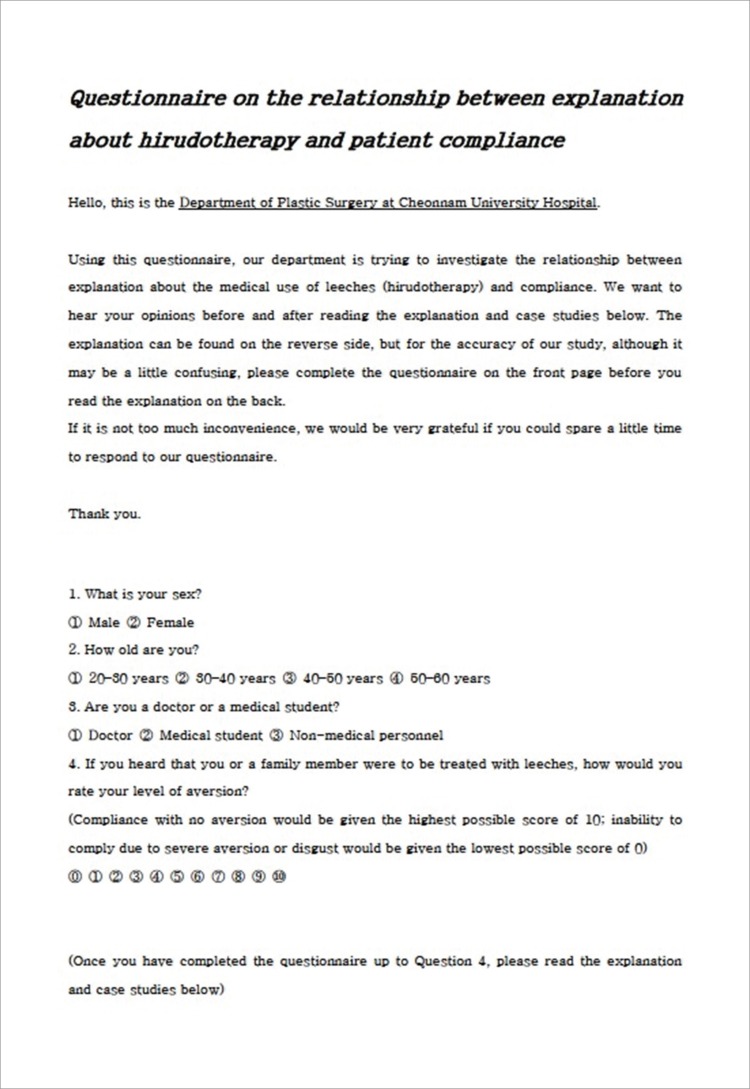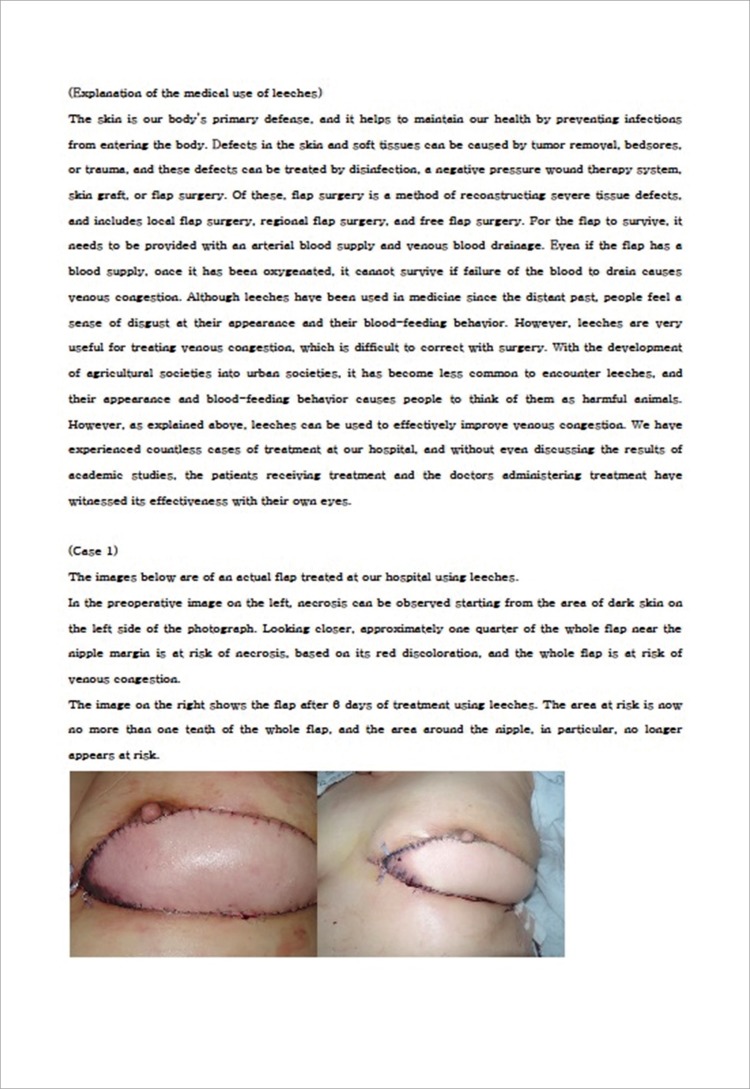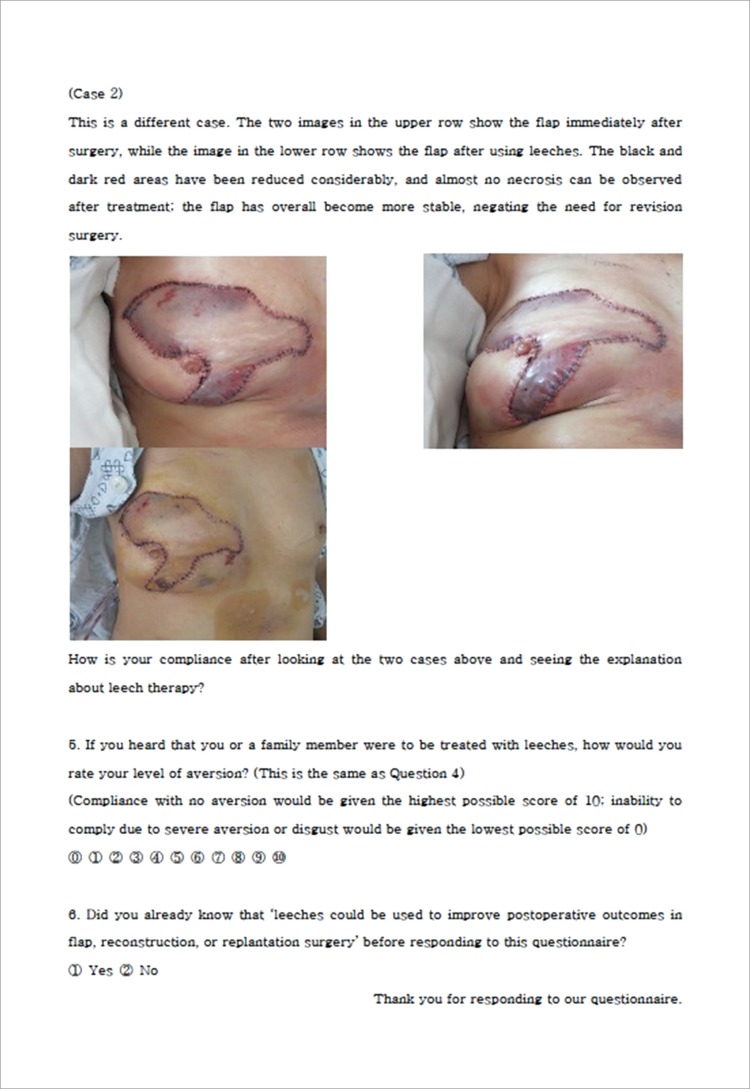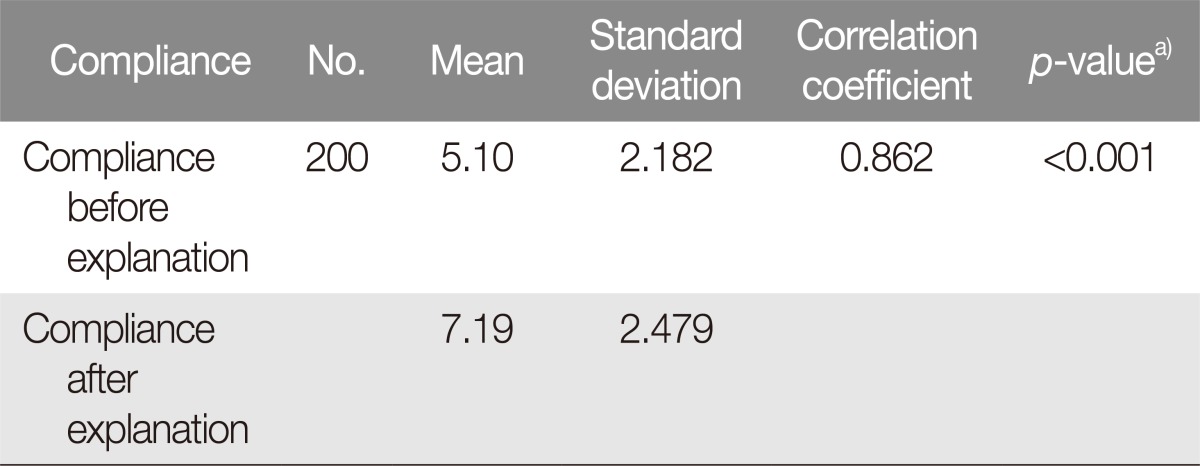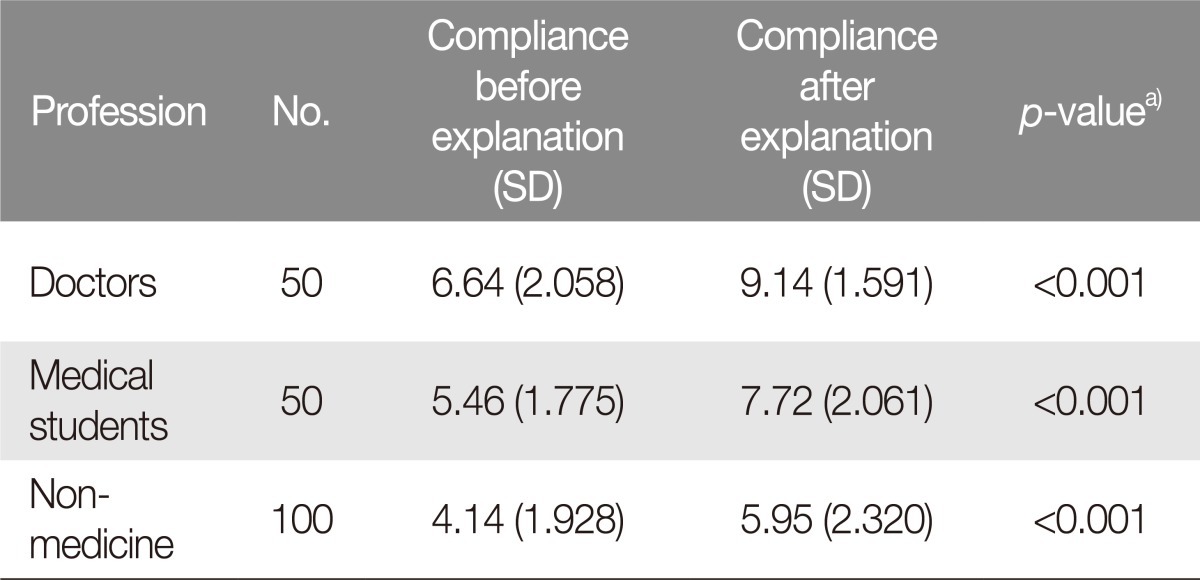 |
 |
- Search
| Arch Craniofac Surg > Volume 18(3); 2017 > Article |
|
Abstract
Background
The use of leeches can effectively increase the salvage rate of flap congestion. However, the first reaction from patients and carers in using leeches in clinical fields is strong aversion. This can be due to the fact that development of our culture from agriculture to industrial society, coming across leeches became fairly rare. Also because of the biological traits that leeches carry; staying attached to a leg or other body parts of the host, sucking blood, and leaving wounds.
Methods
This study was conducted through questionnaires, divided into many subgroups. We scaled the compliance of the two therapies, with or without leech. Maximum scale of 10 showing no rejective response to the therapy and minimum scale of 0 showing the greatest rejective response.
Results
Overall subjects' compliance was improved after explaining the benefits of hirudotherapy. Irrelevant to the explanation, there was no significant difference in general compliance between male and female. Young-aged group and medical personnel or people studying medicine showed higher compliance over older-aged group and the general public.
Conclusion
In the terms of general social cognition, recognizing leech as a therapeutic material may not be welcomed at first, but provided with proper information and explanations, overall compliance of patients and carers can be improved and consequently result in superior outcomes in flap salvage.
Hirudotherapy is a treatment using leeches that was approved by the FDA in 2004. Hirudotherapy utilizes the biological advantages of medicinal leeches [1]. The known fact was that leeches feed on the blood of their host and during the course, release bloodthinning substances like anticoagulants along with their saliva [2]. Following replantation or flap procedure, leeches are used to relieve postoperative venous congestion and salvage the flap [3].
Although there are many reports of leech therapy in the area of microsurgical replantation and flap reconstruction, most patients and carers show aversion the first time they hear about this treatment.
The aim of this study is to understand people's general aversion to hirudotherapy, to analyze differences in the extent of aversion among subgroups, to examine how the extent of aversion changes after subjects receive a thorough explanation of hirudotherapy, and to explore methods of improving patient compliance.
A questionnaire was designed for a total of 200 subjects. In order to perform a subgroup analysis, we administered the questionnaire
to 50 doctors, 50 medical students, and 100 non-medical
personnel. In order to investigate the independent effect of explanation
on the outcomes, we excluded subjects with prior knowledge
that leeches could be used to improve postoperative outcomes
in flap surgery and finger replantation; thus, the ten
subjects who selected answer (1) for Question 6 were excluded,
and the questionnaire was administered to another ten persons,
to make two-hundred subjects in total.
The questionnaire was constructed as follows. On Page 1, the aims of the study were not revealed to subjects to avoid bias in their responses. This page contained questions about subjects' information and ŌĆśpre-explanation complianceŌĆÖ. It consisted of the following items: (Fig. 1). 1. Sex, 2. Age, 3. Profession (doctor, medical student, or non-medical personnel), 4. Compliance to hirudotherapy on a scale of 0ŌĆō10.
Once subjects had completed their responses to Page 1, they were instructed to read the explanation and case reports on Pages 2 and 3. There were no time restrictions and, if required, subjects were provided with thorough explanations of difficult terms such as ŌĆśnecrosisŌĆÖ and ŌĆśvenous congestionŌĆÖ. The explanation was as follows.
ŌĆśThe skin is our body's primary defense, and it helps to maintain our health by preventing infections from entering the body. Defects in the skin and soft tissues can be caused by tumor removal, bedsores, or trauma, and these defects can be treated by disinfection, a negative pressure wound therapy system, skin graft, or flap surgery. Of these, flap surgery is a method of reconstructing severe tissue defects, and includes local flap surgery, regional flap surgery, and free flap surgery. For the flap to survive, it needs to be provided with an arterial blood supply and venous blood drainage. Even if the flap has a blood supply, once it has been oxygenated, it cannot survive if failure of the blood to drain causes venous congestion. Although leeches have been used in medicine since the distant past, people feel a sense of disgust at their appearance and their blood-feeding behavior. However, leaches are very useful for treating venous congestion, which is difficult to correct with surgery.ŌĆÖ
Next, the subjects were provided with images and an explanation about patients who had undergone breast reconstruction at our hospital using a transverse rectus abdominis myocutaneous flap, had been at risk of flap necrosis due to postoperative venous congestion, and had achieved a positive outcome by using hirudotherapy.
The first case introduced in the questionnaire. A 55-year-old woman who underwent breast-conserving surgery for left breast cancer 18 months previously had developed a soft tissue defect after 1 postoperative year due to infection of the inserted mesh (above). Reconstruction surgery was performed using a transverse rectus abdominis myocutaneous flap, but congestion in the medial margin of the flap led to a risk of necrosis. This was treated by hirudotherapy, and the flap color improved within 5 days (below, right).
The second case introduced in the questionnaire (Fig. 3). A woman underwent modified radical mastectomy for right breast cancer 8 years previously; reconstruction surgery was performed using a transverse rectus abdominis myocutaneous flap, but congestion developed in the upper, lateral, and inferior portions of the flap (above). Hirudotherapy was performed, and most of the congestion was alleviated within 6 days (below).
At the bottom of Page 3, the same questions as Page 1 were presented again, in order to check the subjects' ŌĆśpost-explanation complianceŌĆÖ. Finally, a 6th question was presented to exclude subjects who had prior knowledge about hirudotherapy.
The improvement in compliance following the explanation was analyzed for all subjects. Subsequently, the subjects were divided into subgroups according to profession, sex, and age, and the improvement in compliance was analyzed for each subgroup.
In order to analyze the effects of profession, sex, and age on compliance, a one-way analysis of variance (ANOVA) was performed for the three conditions of pre-explanation, post-explanation, and change following explanation. Tukey's method was used for post-hoc testing.
In order to investigate the effects of medical knowledge on compliance, the subjects were divided by profession, into subgroups of 50 doctors, 50 medical students, and 100 non-medical personnel.
In order to investigate the effects of sex on compliance, the 100 non-medical personnel were divided into subgroups of 48 males and 52 females. In order to investigate the effects of age on compliance, the 100 non-medical personnel were divided into subgroups of 29 subjects in their twenties, 20 subjects in their thirties, 27 subjects in their forties, and 24 subjects in their fifties.
Among all subjects, compliance improved significantly after the explanation of hirudotherapy (Table 1).
Statistical analysis of the three subgroups by profession showed a significant improvement after the explanation of hirudotherapy (Table 2).
There was a significant improvement in compliance after the explanation of hirudotherapy irrespective of sex (Table 3).
There was also a significant improvement in compliance after the explanation of hirudotherapy in all age groups (Table 4).
In further statistical analysis of the three subgroups by profession, greater medical knowledge was associated with higher compliance before and after the explanation about hirudotherapy. Analysis of the improvement in compliance showed no significant differences between doctors and medical students or between medical students and non-medical personnel, but there was a significant difference between doctors and non-medical personnel.
Statistical analysis of sex showed, a significant difference between men and women in pre-explanation compliance and post-explanation compliance. The change in compliance was also significantly different between men and women.
We also analyzed the pre- and post-explanation compliance, as well as the improvement in compliance, by age. Pre-explanation compliance showed no significant differences between subjects in the 20s and subjects in their 30s, or between subjects in their 40s and subjects in their 50s. However, when subjects in their 20s and 30s were merged into one group and subjects in their 40s and 50s were merged into one group, there was a significant difference between these two groups.
The group of all subjects showed an improvement in compliance following the explanation, and there were also differences in the improvement according to medical knowledge, sex, and age.
First, in the analysis by medical knowledge, greater medical knowledge was associated with a greater improvement in compliance. Medical knowledge could impact a subject's understanding of the effects of leeches on the flap.
Second, in the analysis by sex, there was a significant difference in pre-explanation compliance between males and females. There were also significant differences between males and females in post-explanation compliance and in the change in compliance. Males showed significantly higher scores for pre-explanation compliance and post-explanation compliance, and also showed a significantly greater increase in compliance. This is thought to be due to differences in the extent of disgust felt towards leeches, and the leeches being received more positively by males than females.
Third, the analysis by age showed that pre-explanation compliance was higher for younger age groups. Post-explanation compliance showed a decrease in the average compliance with increasing age. Although there were no significant differences between subjects in their 20s and 30s, 30s and 40s, or 40s and 50s, there were significant differences between subjects in their 20s and 40s, and between subjects in their 30s and 50s. However, when the change in compliance was analyzed, there were no large differences between subjects in their 20s (1.76 points), in their 30s (2.00 points), in their 40s (1.85 points), or in their 50s (1.67 points), and the one-way ANOVA and post-hoc Tukey's tests also showed no significant difference in the change in compliance between the four groups. Age had no effect on the improvement in compliance. Subjects of younger age could be considered to be more flexible in taking on new scientific facts. However, sex ratios were not consistent among different age groups, which was a limitation during the sample design process. Since sex is a factor that can affect compliance, the results could be made more reliable if the sex ratios were the same across all age groups.
The use of leeches for flap venous congestion management shows different compliance according to the age and medical knowledge of patients and carers. Age, sex, and medical knowledge all showed an effect on the improvement in compliance. Of these, medical knowledge is the only factor that can be changed. Therefore, in order to increase compliance, if the medical knowledge of patients and carers were to be enhanced through continual, in-depth education, it should be possible to reduce their aversion to hirudotherapy.
References
1. Pannucci CJ, Nelson JA, Chung CU, Fischer JP, Kanchwala SK, Kovach SJ, et al. Medicinal leeches for surgically uncorrectable venous congestion after free flap breast reconstruction. Microsurgery 2014;34:522-526. PMID: 24848693.


2. Porshinsky BS, Saha S, Grossman MD, Beery Ii PR, Stawicki SP. Clinical uses of the medicinal leech: a practical review. J Postgrad Med 2011;57:65-71. PMID: 21206115.


3. Praveen N, Deepa CK, Laxminarayan B. Hirudotherapy for flap salvage-report of two cases. Int J Adv Case Rep 2015;2:471-473.
- TOOLS
-
METRICS

-
- 2 Crossref
- Scopus
- 4,210 View
- 56 Download
- Related articles in ACFS
-
Relationship between mandible fractures and third molars2019 December;20(6)
Correlation between Operation Result and Patient Satisfaction of Nasal Bone Fracture2017 March;18(1)




